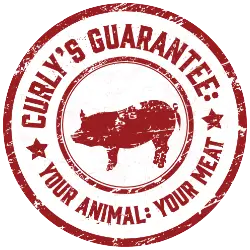Custom Hog Processing

We know that raising hogs isn’t just a pastime; it’s a labor of love. And when it’s time to process, you deserve a custom processor that values your hard work as much as you do. At Curly’s, we guarantee that the hog you bring us is processed into the meat you are delivered. Savor only the finest quality at your table.

Place Your Custom Hog Order
For your convenience, place your pork processing order by submitting the online order form below. We also have a print option here if you prefer to print it out and deliver it to us at the store. Have a few questions? Find our top FAQs here.
Pork Processing Order Form


Custom Hog Processing FAQ
Curly’s vacuum-sealed frozen meat will last approximately two years.
With Curly’s vacuum packaging, we guarantee that 80% of the packages will be tightly sealed. It’s not uncommon for up to 20% of a package to lose its vacuum. Ice crystals may form inside that area, and we suggest you simply use those packages first. If you are concerned with the number of packages that have lost their vacuum, you are more than welcome to bring those packages back for re-sealing at no charge.
Yes, of course you can! You can choose between various cuts like chops, roasts and bacon and request specific package sizes for bulk sausage. However, it’s essential to communicate your preferences clearly with us ahead of time via our online form or by dropping off the printed form in the store.
The weight of the pork before processing is known as the “hanging weight” or “carcass weight.” It’s determined by weighing the carcass after the animal has been slaughtered but before it has been processed into cuts of meat. This weight includes bones and some fat that may not be part of the final cuts.
Typically, the yield is around 50-60% of the hanging weight. For example, if the hanging weight of a hog is 200 pounds, you can expect to take home approximately 100-120 pounds of meat.
Several factors can affect the yield of meat from a whole hog, including the breed of the pig, its diet, how it was raised, the age at slaughter and the amount of fat and muscle on the carcass. Additionally, how the meat is processed (how much fat is trimmed, bone-in vs. boneless cuts, etc.) will also affect the yield.

